MNT Pocket Reform is an open-source hardware mini laptop with a 7-inch Full HD display, an ortholinear mechanical keyboard, and trackball, that follows the path of its older and bigger sibling: the MNT Reform 2 laptop initially launched with an NXP i.MX 8M quad-core Arm Cortex-A53 module. The new laptop will not only support a similar “NXP i.MX 8M Plus” module but also a range of other Arm modules namely an NXP Layerscape LS1028A module with up to 16GB RAM, the Raspberry Pi CM4 module via an adapter, Pine64 SOQuartz (RK3566, up to 8GB RAM), as well as based on AMD Xilinx Kintex-7 FPGA for industrial use. MNT Pocket Reform specifications: Available system-on-modules Standard: NXP i.MX 8M Plus quad-core Arm Cortex-A53 @ 1.8GHz with 4 or 8 GB DDR4, Vivante GC7000UL GPU, 2.3 TOPS NPU NXP Layerscape LS1028A dual-core Arm Cortex-A72 with 8 or 16GB DDR4, Vivante GC7000UL GPU Raspberry […]
Mixtile Edge 2 Kit mini PC/IoT gateway supports an external 20Ah battery pack
Mixtile Edge 2 Kit is a mini PC/IoT edge computer powered by a Rockchip RK3568 quad-core Cortex-A55 processor coupled with up to 4GB RAM and 32GB flash that features a 12V SATA + SMBUS port that allows the insertion of a 20Ah battery pack lasting up to 12 hours for locations where power may be intermittent. The 3.5-inch industrial mini PC also offers Gigabit Ethernet and WiFi 6 connectivity, three USB 3.0 ports, plus expansion with M.2 and mPCIe sockets, as well as a similar U.2 connector found in the company’s Mixtile Blade 3 SBC powered by Rockchip RK3588 processor, but routed to different interfaces. Mixtile Edge 2 Kit specifications: SoC – Rockchip RK3568 quad-core Arm Cortex-A55 processor @ up to 2.0 GHz with Mali-G52 EE GPU, 0.8 TOPS NPU, 4Kp60 H.265/H.264/VP9 video decoder, 1080p100 H.265/H.264 video encoder System Memory – 2GB or 4GB LPDDR4 Storage 16GB or 32GB eMMC […]
Bambu Lab X1 – A color 3D Printer with LIDAR and AI for improved accuracy, ease of use (Crowdfunding)
3D printing can be time-consuming and challenging, and even today, it’s still not as easy as using a photocopier, but the team at Bambu Lab has taken it upon itself to make a better, easier-to-use 3D printer with the X1 color 3D printer combining LIDAR and AI technology to level the bed, calibrate the prints, and detect anomalies. The Bambu Lab X1 3D printer supports up to 16 colors, is making removing support easier with snap-away material or dissolvable filament, can handle PC and PA-CF filaments beyond the traditional PLA and PETG filaments, manage up to 500 mm/s prints, and provides better prints with features such as active vibration compensation. Oh, and you don’t need to assemble it, since it comes fully assembled and ready to use out of the box. There are two models of the 3D Printer with X1 and X1 Carbon with the latter featuring more sturdy […]
A RISC-V laptop or mini PC with Rockchip RK3588-class performance may be coming soon
Mark Himelstein, Chief Technology Officer, RISC-V International, and Dr. Philipp Tomsich, Chief Technologist & Founder, VRULL GmbH hinted that we may see a RISC-V laptop in 2022 in a presentation entitled “From Technology to Product – Maturing the RISC-V Ecosystem” with one of the slides showing what could be a RISC-V laptop prototype and The Register suspected it might come from the Institute of Software at the Chinese Academy of Sciences (ISCAS) since it was planning to build 2,000 RISC-V laptops by the end of 2022. But there’s at least one more potential RISC-V laptop project coming our way with StarFive asking users to fill out a survey about a laptop, mini PC, or development board/SBC based on a RISC-V SoC with performance comparable to Rockchip RK3588 or MediaTek MT8192 octa-core Cortex-A76/Cortex-A55 processors. The hardware and software specifications of the device will depend on the answers to the survey. First, it’s […]
DevTerm portable Linux terminal now supports Raspberry Pi CM4 via a $19 adapter
DevTerm modular, portable Linux terminal initially designed for modules based on Raspberry Pi CM3 form factor, can now work with Raspberry Pi CM4 for extra performance and memory thanks to a $19 adapter. The Devterm was initially launched in 2020 with a 6.8-inch IPS screen, a keyboard with 67 keys, and a battery module, all connected through the ClockworkPi v3.14 carrier board taking a choice of core modules based on Allwinner H6 or Rockchip RK3399 (now supported in Armbian), besides the Raspberry Pi Compute Module 3 mentioned above. More recently, it also got an Allwinner D1 RISC-V module. The Raspberry Pi CM4 module should bring performance similar to the Rockchip RK3399 module for most tasks, although it may vary a lot depending on workloads, and for regular Raspberry Pi users, software that will be more familiar, and may be better supported. I’ve just a bit surprised it took so long, […]
Kontron D3723-R – An AMD Ryzen Embedded R2000 motherboard in mini-ITX form factor
Kontron D3723-R is an industrial mini-ITX motherboard equipped with the just-announced AMD Ryzen Embedded R2000 processor family that delivers higher performance than Ryzen R1000 Series while keeping the costs lower than AMD Ryzen Embedded V2000 solutions, and enabling Windows 11 support. Manufactured in Germany, the Kontron D3723-R will be offered with Ryzen R2312, R2314, R2514 and R2544 SKUs, and be particularly suitable for embedded graphics applications such as professional casino gaming systems, medical displays, thin clients, industrial PCs, infotainment, and digital signage systems. Kontron D3723-R specifications: SoC (one of the other) AMD Embedded R2312 dual-core/quad-thread processor @ 2.7 / 3.5 GHz (Turbo) with 3-core AMD Radeon Vega Graphics; 12-35W TDP AMD Embedded R2314 quad-core processor @ 2.1 / 3.5 GHz (Turbo) with 6-core AMD Radeon Vega Graphics; 12-35W TDP AMD Embedded R2514 quad-core/eight-thread processor @ 2.1 / 3.7 GHz (Turbo) with 8-core AMD Radeon Vega Graphics; 12-35W TDP AMD Embedded […]
MaaXBoard 8ULP SBC leverages NXP i.MX 8ULP Cortex-A35/M33 SoC for Edge audio and HMI applications
Avnet MaaxBoard 8ULP will be one of the first single board computers (SBC) based on the new NXP i.MX 8ULP Cortex-A35/M33 processor designed for Edge audio and HMI applications, and featuring NXP’s EdgeLock for device-to-cloud security. The board will come with 2GB RAM, 32GB eMMC flash, a MIPI DSI display connector, a MIPI CSI camera connector, Fast Ethernet and WiFi 5 connectivity, a digital microphone, and a 3.5mm stereo audio jack, and provide expansion capabilities via a 40-pin header for Raspberry Pi HATs and a 16-pin Shuttle Click header for MikroE Click add-on boards. MaaXBoard 8ULP SBC specifications: SoC – NXP i.MX 8ULP processor with 2x Arm Cortex-A35 core @ 1.0 GHz, 1x Arm Cortex-M33 real-time core @ 216 MHz, 1x HiFi 4 audio DSP @ 600 MHz, 1x Fusion DSP @ 200 MHz for low-power voice and sensor hub processing, as well as 2D and 3D GPUs and 768 […]
Arm Linux IoT gateway ships with up to 8GB RAM, offers dual GbE, 4G LTE, WiFi 6, BLE 5.3, GNSS connectivity
Compulab IOT-GATE-IMX8PLUS is a new Arm Linux IoT gateway powered by NXP i.MX 8M Plus SoC with up to 8GB RAM, 128GB storage, and plenty of connectivity options with dual Gigabit Ethernet, WiFi 6, Bluetooth 5.3 LE, and 4G LTE connectivity, as well as GNNS support and RS485/RS232 interfaces. The new IoT gateway builds upon theArm SystemReady IR certified IOT-GATE-IMX8 industrial gateway, but offers more RAM and storage, a 2.8 TOPS AI accelerator (in the NXP processor), improved connectivity, as well as a DVI-D port for video output. Compulab IOT-GATE-IMX8PLUS specifications: SoC – NXP i.MX8M Plus Quad or Quad-lite quad-core Arm Cortex-A53 processor @ up to 1.8 GHz with Arm Cortex-M7 real-time core @ 800 MHz, Vivante GC7000UL 3D GPU, Vivante GC520L 2D GPU, 1080p H.265/H.264 video decoder & encoder, HiFi 4 DSP, 2.3 TOPS Neural Processing Unit (NPU) System Memory – 1GB to 8GB LPDDR4 Storage – 16GB to […]










